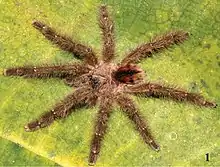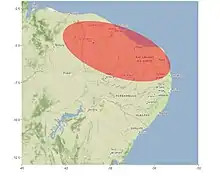| Typhochlaena curumim | |
|---|---|
 | |
| Scientific classification | |
| Domain: | Eukaryota |
| Kingdom: | Animalia |
| Phylum: | Arthropoda |
| Subphylum: | Chelicerata |
| Class: | Arachnida |
| Order: | Araneae |
| Infraorder: | Mygalomorphae |
| Family: | Theraphosidae |
| Genus: | Typhochlaena |
| Species: | T. curumin |
| Binomial name | |
| Typhochlaena curumin Bertani, 2012[1] | |
 | |
Typhochlaena curumim is a species of tarantula, that is native to Mata do Pau-Ferro, Areia, in the state of Paraiba, Brazil. It is a member of the subfamily Aviculariinae.[2]
Etymology
The specific name is derived from the Brazilian indigenous Tupi language, meaning "child". It refers to the local children that found the type specimens high in a tree in Areia, State of Paraíba, Brazil, during an arachnological expedition.[2]
Characteristics
Typhochlaena curumim is only known from the female. It has a brown cephalothorax and legs, but the abdomen is metallic yellowish-green with a black dorsum with five black stripes extending laterally. It is characterized by the spermatheca, which is wide at the basal region but thins to a single or bifid spiralled region.[2]
References
- ↑ "Taxon details Typhochlaena curumim Bertani, 2012", World Spider Catalog, Natural History Museum Bern, retrieved 2016-03-10
- 1 2 3 Bertani, R. (2012), "Revision, cladistic analysis and biogeography of Typhochlaena C. L. Koch, 1850, Pachistopelma Pocock, 1901 and Iridopelma Pocock, 1901 (Araneae, Theraphosidae, Aviculariinae)", ZooKeys (230): 1–94, doi:10.3897/zookeys.230.3500, PMC 3494022, PMID 23166476
This article is issued from Wikipedia. The text is licensed under Creative Commons - Attribution - Sharealike. Additional terms may apply for the media files.